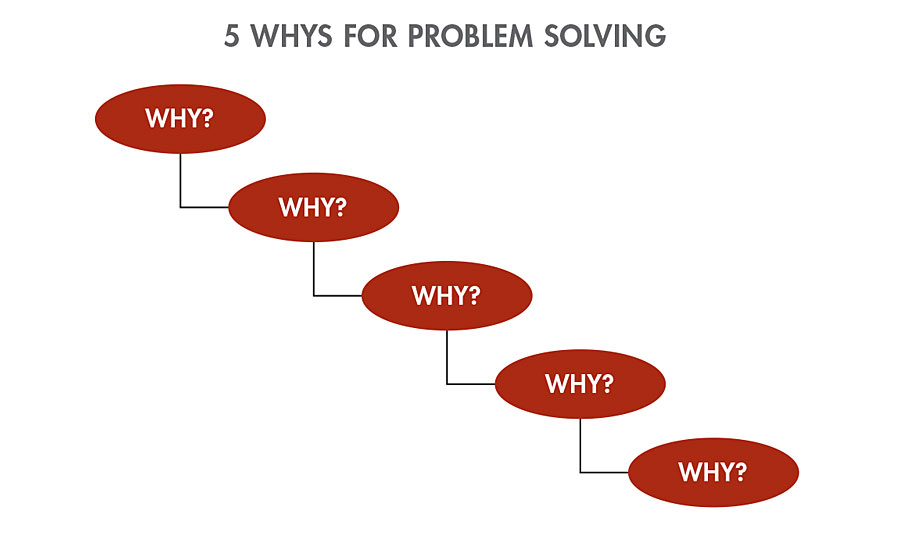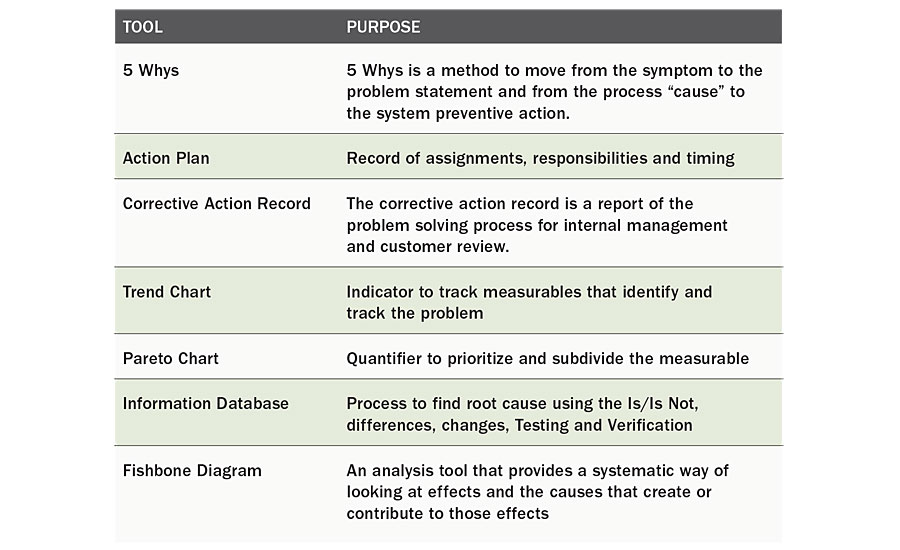Getting to the Root Cause
Aiming performance improvement measures at root causes is more effective than merely treating the symptoms of a problem.










Problem solving is finding the root cause of a problem and preventing it from ever happening again. Problem solving is not putting a Band-Aid on the problem. Create a work instruction to use when you have to perform a root cause analysis. If you have an instruction, all of the elements will be completed the same way each time.
Root Cause Analysis involves:
- Defining the problem in descriptive or quantifiable terms
- Determining the root cause condition(s)
- Verifying the Root Cause
Actions taken when using the Corrective Action Process:
Containment
Protect the customer, product or process
Corrective Action
Eliminate the designated Root Cause(s)
Preventative Action
Implementation of actions to prevent recurrence of the root, contributing or direct cause conditions
Root Cause Analysis is the process used to reach the primary cause or causes of a problem. Root cause is the core reason or reasons that the problem exists.
Aiming performance improvement measures at root causes is more effective than merely treating the symptoms of a problem.
Root Cause Analysis (RCA) is effectively performed on the issue. RCA is performed systematically, with conclusions and causes backed up by documented evidence.
There is usually more than one potential root cause for any given problem.
To be effective the analysis must establish all known causal relation-ships between the root cause(s) and the defined problem.
Root cause analysis transforms an old culture that reacts to problems to a new culture that solves problems before they escalate, creating a variability reduction and risk avoidance mindset.
The basic elements of RCA may include the following. However, this list is just a starting point.
Materials
Defective raw material
Wrong type of material for the job
Lack of raw material
Machine / Equipment
Incorrect tool selection
Poor maintenance or design
Poor equipment or tool placement
Defective equipment or tool
Environment
Orderly workplace
Job design or layout of work
Surfaces poorly maintained
Physical demands of the task
Forces of nature
Management
None or poor management involvement
Not paying attention to the task
Task hazards not guarded properly
Other (horseplay, inattention....)
Stress demands
Lack of Process
Methods
Practices are not the same as written procedures
Poor communication
Management system
Training or education lacking
Poor employee involvement
Poor recognition of hazard
Previously identified hazards were not eliminated
Put a cross-functional team together before you start your problem solving steps.
Problem Solving Steps
Assemble a cross function team to work on the problem.
Problem Statement
Describe the problem in descriptive or quantitative terms. Establish the operational definition or problem statement and observe the process. Gather information on previous defects and determine where in the process the defect is happening.
Containment needs to be performed to protect the customer from receiving any bad product.
Describe in as much detail the symptoms of the rejection.
Find the Root Cause and Verification
Prepare a Cause and Effect Diagram
Review and update the Process Flow Diagram (if necessary)
Repeated 5 Whys
Identify the difference in good versus bad
Notes: The key to finding the root cause is asking the question: “What Changed?”
In listing the changes, dating the change is critical. Think about how the date of a change can be helpful.
Develop Theories
Record ideas of what could have happened using the brainstorming method
Test and eliminate potential root causes and verify the selected root causes.
ROOT CAUSE QUESTIONS
Is there a relationship between the problem and the process?
Is this a unique situation or is it the root cause? Is it similar to previous rejections?
Why have we not we experienced the problem before?
What changed?
- Do you have new suppliers?
- Change in tooling or new tools?
- New operators?
- Did the process change?
- Did the measurement system change?
- Are the raw materials used the same?
- Are we using customer supplied product?
- Do other similar operations have the same problem?
Barriers to Root Cause Analysis
Not using a system
Leads to incorrect root causes
Unverified corrective actions
Lack in customer satisfaction
Using the incorrect tool
Not following the corrective action format
Over-reliance on experience
Keep the guesswork out of the process
Keep an open mind
Resistance to change
We have always done it this way
7. Select the Permanent Corrective Action
Choose and verify the best action
Validate with before and after data
Permanent Corrective Action Questions
What Permanent Corrective Actions did you consider?
What indicators have we used to verify the PCA?
Are the indicators related to the root cause(s) of the problem?
What is the frequency and interval that we need to measure this problem?
Hourly
Daily
Weekly
Monthly
What methods will you use to verify the effectiveness, both in the short term and to predict the long-term results?
Is the PCA acceptable to the customer?
Will this PCA create other problems?
Implement Permanent Corrective Action
Construct an action plan and plan the prevention and protection actions. Validate (PCA) with the original problem indicator. Update the FMEA and all of the other related documents.
Implementation Questions
Have you defined the action plan?
Have you assigned the responsibilities?
Have you established the timing?
Have you obtained the required support?
What indicators are you planning to use to verify the outcome of the actions, both short term and long term?
Have you communicated the action plan to all parties?
What controls do you plan to put in place to assure the permanent fix is working?
Prevent Recurring System Problems Questions
Can we use our improvement on another existing process?
What allowed this problem to occur?
Was it a failed procedure?
Was it a system breakdown or failure?
Did we use our best practices?
What practices do we need to standardize?
Have you written the plans to coordinate the actions?
Who is responsible?
What are the action items to be completed?
Assign a date for the action items to be completed.
How will we communicate the new practices to all of employees affected by the change?
Are document updates necessary?
Flow Chart
FMEA
Control Plan
Work Instructions
Digital Photos
Samples Good and Bad
Routing/Traveler
PPAP
8. Congratulate the Team
Determine the appropriate recognition, and celebrate successful completion.
Looking for a reprint of this article?
From high-res PDFs to custom plaques, order your copy today!









